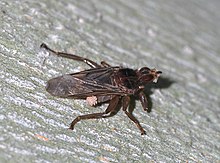Pseudolynchia canariensis
| Pseudolynchia canariensis | |
|---|---|
 |
|
| Scientific classification | |
| Kingdom: | Animalia |
| Phylum: | Arthropoda |
| Class: | Insecta |
| Order: | Diptera |
| Family: | Hippoboscidae |
| Genus: | Pseudolynchia |
| Species: | P. canariensis |
| Binomial name | |
|
Pseudolynchia canariensis (Macquart, 1839) |
|
| Synonyms | |
Pseudolynchia canariensis, the pigeon louse fly or pigeon fly, is a species of biting fly in the family of louse flies, Hippoboscidae.
They are found in most parts of the (sub-)tropical world where domestic pigeons are kept. Known from wild hosts in Continental Africa, Mediterranean Sub-region, Afghanistan, India, Bangladesh, Nepal, Thailand, Taiwan, Ryukyu Islands, The Philippines, Malaya, and Indonesia.
The only wild hosts are Pigeons and Doves (Columbidae). In domestic settings they have been recorded from 33 genera, 13 families, 8 orders of birds.
P. canariensis is the intermediate host for the protozoan Haemoproteus columbae or pigeon malaria. This parasite can be fatal to young Pigeons.
Ischnoceran lice are often found on several hippoboscid flies. This is a phoretic association and the lice do not feed on the flies.
Pigeon flies themselves are commonly infested with a mite Myialges anchora.
...
Wikipedia
